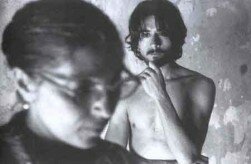The true story of Peppino Impastato remains one of modern Italy’s most important. Now considered a key historical figure from the 1970’s, his legacy was further entrenched in the hearts and minds of Italians with the biographical tale I Cento Passi (The Hundred Steps). The anti-mafia activist was outspoken and wanted to make a difference to his local community – it didn’t matter that he was indirectly a part of the Mafia family.
It must first be said that the term ‘Mafia’ is used quite broadly – it specifically refers to the organizations within Sicily alone. So in The Hundred Steps we see the ‘real’ Mafia and their influence (for we are again looking at Sicilian life), as we are led through Peppino’s childhood in the 1950’s to adulthood in the 70’s. It’s important to know that 1970’s Italy was filled with terrorism, ‘The Leaden Years’ a volatile time after the re-consolidation of Mafia group Cosa Nostra. Peppino’s story is just one of many, with student protests at the time gathering Communist support to fight organised crime.
 |
Affected by the death of his Uncle Cesare as a boy, Peppino is intrigued by local artist/activist Stefano Venuti about Communist ideals; the movement was still a force at the time post-WWII. He eventually sets up Radio AUT to promote change and resistance, which reaches across hometown Cinisi (just outside Palermo). The message hits hardest at home, where Peppino’s father Luigi must deal with his son’s consequences. His journey is just as fascinating as his son’s, dealing with an outspoken child who happens to be offending those he works for – ‘Uncle’ Tano Badalamenti. As the middle man, The Hundred Steps shows Luigi’s slow emasculation – he loses his sense of control as a patriarchal figure; of both the family and the mafia, and that is seen at its best during a struggle with Peppino that seemingly foreshadows the doom to come. His death (for there are many in this film) is the most surprising, but the most important – who can protect Peppino from the powers that be if his father can’t?
Even the worst things, once they’re done, find a logic for the mere fact of existing
Death is a prevalent and important part of Sicilian culture. In The Hundred Steps, death is what shapes Peppino to become who he is, and shapes his questions about his morals and his family. Throughout the film we learn of his frustrations – he literally walks circles around brother Giovanni (after ‘the hundred steps’ from their house to Uncle Tano’s) in a striking scene that reveals his inner tension. The close proximity was a major blockade that Peppino unsuccessfully tried to distance himself from. Buonamico Buffalmacco’s fresco painting Death’s triumph over living suggests to some that death does triumph over those having too good a time in life, even with their ‘faults’ of wealth (those not necessarily of their choice). During Peppino’s life there were good times – he was worshipped by those who believed his views.
|
|
Within the film adaptation, Marco Tullio Giordana (director of 6-hour epic The Best of Youth) turns to subtle Christ imagery to reveal the religious undertone of Italy’s history as well as the theme of death. Peppino is shown as gaunt and unshaven during a more difficult time, while the only violent image we are shown is that of his bloodied, beaten face before we see his trussed body. The deaths in The Hundred Steps are not glorified, but Giordana instead uses blinding white light to segue into the next scene (presenting obvious connotations). Lighting in the film is important, and viewers should note the use of red light on the characters in key scenes. Music plays an even bigger part, used to get not just local, but international audiences to take interest. Reflecting young Italians’ music taste today (so I’m told), Bob Dylan, Janis Joplin and Procul Harum are contributors towards what’s quite possibly the most effective soundtrack ever put to film – a big call, yes, but it’s definitely up there. Giordana uses the music to stir up such a range of emotions, from tension and youthfulness (with Sweet’s great Ballroom Blitz) to a final feeling of melancholy put with a montage featuring the real Peppino.
It could be argued with The Hundred Steps that Sicilians no longer see the more distant past as determining their history. However, to educate the audience, Giordana maximised the authenticity – using real transcripts from the Radio AUT broadcasts, using the music at the time and casting Luigi Lo Cascio as Peppino, who bears a remarkable resemblance to the real subject. The film was a huge box office hit during its 2000 release, resulting in more accessible information on the Mafia for the public. Italians embraced the chance to learn more about a modern hero of their country and it proved that problems still run deep – with not just organised crime but how it tears families apart. The Hundred Steps is a great example of political awareness in cinema that doesn’t try to saturate you with information, but gives a front-seat ride on the rollercoaster of an influential man’s life.
 Follow the author Katina Vangopoulos on Twitter.
Follow the author Katina Vangopoulos on Twitter.








![Gomorrah [Gomorra] (Review) Gomorrah [Gomorra] (Review)](/wp-content/uploads/scena-gomorra-il-film1-150x150.jpg)








